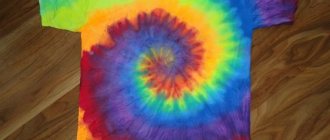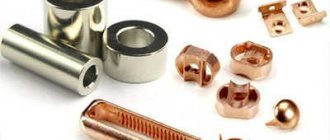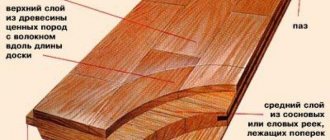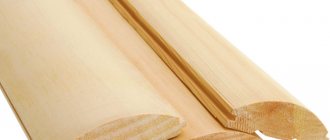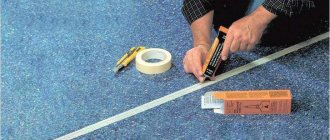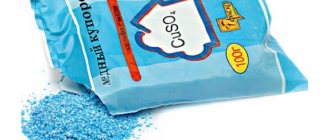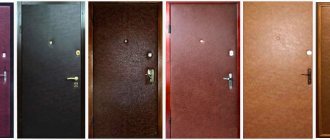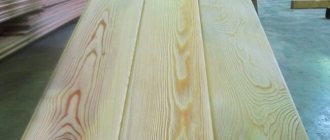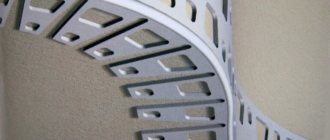Among the numerous building materials, plywood should be highlighted. It can be used for a variety of purposes. Good workability determines that the material in question is often used in the independent manufacture of furniture, home decoration, carpentry and other purposes. The most common question is how to bend plywood.
Features of plywood
There is already plywood on sale that is bent at a certain angle. But in most cases its thickness is no more than 4 mm, which is not enough to solve many problems.
Plywood bending is often done at home. This material has become widespread for the following reasons:
- Reasonable price.
- Quite high strength.
- Can be bent to almost any shape.
- Good machinability.
- Suitable for making various products.
- It is possible to coat the surface with paint or varnish.
The main characteristics of the material are primarily related to the multilayer structure. This point also determines that after giving the shape it remains for a long period.
Main characteristics of the material
Plywood is a multi-layer board-type material. Veneer sheets are used as the basis for production, which are laid on top of each other in a cross position and glued together with a composition containing resins and formaldehyde.
The strength of the finished material is ensured by the cross arrangement of the veneer. That is, in one slab the transverse and longitudinal directions of the fibers alternate, which means additional resistance to mechanical loads is acquired.
This is a significant advantage, but if you have to bend plywood with your own hands, high strength turns into a disadvantage. Let's find out how to bend plywood at home and get the desired result.
Steaming and soaking plywood
Steam lumber processing table
Steaming plywood is perhaps the most common way of deforming laminated lumber. The advantage of this method is that it is equally relevant in both industrial and domestic conditions.
The bending instructions are not complicated, provided that you are going to deform the material no thicker than 4 mm.
We will need the following from the tool:
- kitchen stove;
- large saucepan with lid;
- strong, high temperature resistant rope;
- kitchen mittens.
Instructions for working with the material are as follows:
- fill the pan halfway with water and put it on the fire;
- We lay plywood on top of the pan, so that the area to be bent is located above the water;
- Place a lid on top of the laid material so that it covers the pan as much as possible;
- from the moment the water boils, time it for 10-15 minutes;
- after the specified time, bend the plywood so that an angle of 160-150 degrees is formed;
- We tie the ends of the bent material with a rope to fix the resulting bend shape;
- We again place the material over steam for 10-15 minutes, after which we bend it another 20 degrees;
- We repeat the procedure until we achieve the required angle of curvature;
- After the desired angle is obtained, we leave the product in a tightened form until the wood is completely dry.
Important: To provide the bend with a rounded shape, it is advisable to place some kind of round roller in this area, for example, a large tin can or something more suitable in size.
In the photo - soaking the workpiece in hot water
Plywood bending methods
How to bend plywood is often considered due to the fact that the material is suitable for creating complex products. The most common bending methods are:
- Gluing.
- Steaming.
- Notching.
- Hydration.
You can find complex plywood products on sale. Bending in industrial conditions is carried out by combining several different methods.
When paying attention to how to bend plywood, there are several difficulties to consider. Taking into account the bending method chosen, they are as follows:
- As the sheet thickness increases, more force has to be applied. At home, workpieces with a thickness of up to 40 mm are processed.
- The structure is represented by veneers, which are located relative to each other at a certain angle. Due to this, the product is given greater strength. Therefore, the workpiece can only be bent if it is pre-processed.
- Too much force causes cracks to appear inside the structure. If you bend the workpiece incorrectly, it will no longer be possible to restore its condition.
Bent plywood quickly loses its heat after heating. Therefore, you need to give the required shape at home before it cools completely.
Steaming
When heated, wood becomes more flexible, making it easier to process. At home, it is possible to increase the temperature of the material by placing it in a sealed container with steam. The recommendations are as follows:
- At a temperature of 60 °C, the exposure time increases by 2 times. Only after this can the part be bent.
- If soaking is carried out at a water temperature of 15-30 ° C, it will be difficult to bend the part.
The template is created in advance, special attention is paid to size and shape. It is required to fix all surfaces at the required angle relative to each other. The workpiece is fixed to the template and left to dry completely in a sealed container with warm steam. How to straighten plywood using this method? It is enough to steam the part and make it straighter, fix it in this position and let it dry. The method is suitable for creating original designs that will be used in industry or in everyday life.
Notching
If plywood with a thickness of 16-22 mm needs to convey a complex shape, then the notching method is used. Special grooves are created using a milling cutter. When carrying out such a procedure, the following should be taken into account:
- Markings for the grooves are made at the location of the future bend.
- The depth is set depending on the thickness of the material and should not exceed half.
- A sheet of veneer is glued on top.
It takes about a day to consolidate the result. The formed grooves can be filled with adhesives. How to bend plywood if it is thin? In this case, another method is used.
Gluing
The gluing method has also become widespread. To give the required shape, a template is created from a thin sheet of material. The plywood plate is bent over the surface. PVA glue is used for gluing individual sheets; it is distributed in an even layer over the surface of each sheet.
PVA glue for plywood dries in about a day. During this period, all sheets are fixed using clamps. At the end of the procedure, all irregularities and protrusions are polished.
Hydration
Moisture also significantly increases the flexibility of wood. The moistening method involves soaking the workpiece in a bathtub or under running water. Do not forget that too high humidity can cause the material to delaminate. Therefore, before actually performing the work, you need to test the method on a small piece of material.
You can moisten the plywood yourself. The procedure consists of several stages:
- The workpiece is soaked in the bath.
- The softened workpiece is placed according to the template.
The degree of hardness is checked every 5 minutes.
In most cases, it takes no more than half an hour to achieve the required degree of elasticity. Only after all layers have completely dried can you begin further work. The primitive method has been used for many years, since it can be carried out even in the absence of special equipment. Humidification timing chart
| Three-layer material, thickness mm | Carrying out the procedure along the fiber, min | Across the fiber direction, min | Five-layer material, thickness | Carrying out the procedure along the fiber, min | Across the fiber direction, min |
| 1 | 15-20 | 10-15 | 1 | 60-90 | 60-90 |
| 1,5 | 20-40 | 15-20 | 1,5 | 90-120 | 90-120 |
| 2 | 40-60 | 20-30 | 2 | 120-150 | 120 |
| 2,5 | 60-90 | 60 | 2,5 | 150-180 | 120 |
| 3 | 90-120 | 90-120 | 3 | 180-240 | 150 |
| 4 | 180 | 120 | 4 | 240-300 | 180-240 |
Differences in metal thickness
The thicker the metal being bent, the higher the structural load on the beams and moving parts. The pull on machines for metal up to 2 mm is usually manual, but the design of the rotary joints and the drive lever can be different.
In repair and construction, metal with a thickness of more than 0.6–0.8 mm is rarely bent on machines; usually, tin for air ducts and roofing iron fit into these frames. With such insignificant loads, there is no need to provide a safety margin; almost any breakdown appears as a consequence of defects or technical imperfections of the faulty unit.
The beams of the machine for bending thicker rolled products have a reinforced structure. They are usually cast and wide; on the back side you can see longitudinal and transverse stiffeners. This also applies to most portable machines, where the greater thickness of the beams has a negative impact on weight. And yet, the greatest load falls on the hinge-lever mechanisms, especially at the points of attachment to the beams.
Welding is rarely used in such areas, but is usually a bolted connection on intermediate brackets, much like a handrail system on public transport. In low-grade equipment, these parts are made by powder casting, which is passed off as a heavy-duty alloy. After a couple of years of active use, the parts become covered with cracks due to the load, and over time they finally break. The price of a sheet bending machine is often proportional to the quality of its workmanship.
Necessary equipment
The required fixtures and tools largely depend on which bending method has been chosen. In some cases you need:
- A template by which a form is given. How to level plywood? For straightening, a regular board with the required rigidity is often used.
- Device for clamping a workpiece.
When choosing a moistening method, you need a bath in which the workpiece will be soaked. In case of steaming, an airtight container is required. An electric tool, such as a grinder, is used to create grooves.
Complex plywood structures
There are a large number of different plywood parts on sale that have complex shapes. The most common arches are for doorways. The soaking method is suitable for creating original designs of almost any complexity. In this case, you need to take into account:
- A template is prepared in advance.
- Fixation is carried out using special clamps. When clamping, it is necessary to eliminate the possibility of damage to the surface, since after soaking the surface becomes softer.
Despite the flexibility of plywood, not all complex shapes can be given to it. Too many transitions cause loss of strength.
Gluing
Gluing plywood
To give plywood a curved look, a “pattern” piece is cut out of a thin sheet of plywood. It is laid on the sheet in such a way that the direction of the veneer alternates. As a result, the structure will have the necessary ductility and rigidity. Each layer of plywood is glued together with epoxy glue. To give the shape, the workpiece is clamped with clamps for one day. After drying, all irregularities and any exposed glue are removed from the part. Once completed, the workpiece is sanded.
How to bend plywood at home step by step instructions
When considering how to bend plywood at home, you need to take into account that there are certain restrictions on the thickness of the workpiece. Using the sawing method, we bend the plywood as follows:
- Bending plywood begins with marking the surface.
- In order to give the shape you need to determine the number of cuts. As the radius along which the part needs to be bent increases, the number of grooves also increases.
- The required cuts are made. The electric tool used must be adjustable for cutting depth and groove width.
You can bend 10 mm plywood using the steaming method. In this case, the likelihood of surface damage is reduced. Drying is carried out until excess moisture is gone. A plywood table or other product will not last for a long period in high humidity environments.
What is it for?
Ready-made bent-glued plywood board is actively used to produce products of unusual shapes, which decorate any living space with their exquisite appearance. The most popular items are:
- decorative elements of cabinets, walls, cabinets, dressing tables, drawers, shelves and low shelves;
- latoflexes (frames) for beds;
- comfortable chairs or rocking chairs;
- ordinary blanks for creative looking chairs or original inserts for armchairs and sofas;
- stylish facades for solid cabinet structures;
- office chairs, hard chairs, inexpensive furniture products for schools, hospitals and hotels;
- stylized elements for dining tables and small tables.
Products made from flexible veneer are always elegant and fashionable and for this reason they can easily give any room in your home a pleasant appearance.
About choosing a method
The choice of method depends on the characteristics of the future product. They are as follows:
- The bending radius across is much smaller than along. The product can be bent or rounded at different radii; as it increases, the strength decreases.
- The part that has been bent should be stored in a dry room with low humidity. If this condition is not observed, the product may lose its shape.
- When choosing the steaming method, the shape is transferred to the workpiece before cooling. In this case, it is much more difficult to straighten the part. Alignment is associated with returning the structure to its original state. If the bending was carried out in violation of the technology, then the veneer distribution alternated incorrectly.
Even minor defects can cause the part to fail to bend; if force is applied, it may burst. Products can be bent from plywood according to a template, for which the home workbench is equipped with special clamps.
Steaming and bending video
We present to your attention a video about the technological process of bending wood:
Good luck and success! Until we meet again, Andrey Noak was with you!
—Categories
- Textiles. Various ideas for working with materials (868)
- Rag rug or what can be made from old things (275)
- Sewing (175)
- Teddy bears (120)
- Leather (97)
- Clothing designers, fashion (57)
- Fabric flowers (48)
- Batik (33)
- Indian patchwork (11)
- Soutache (7)
- Knitting (854)
- Spokes (502)
- Hook (244)
- On the fork (9)
- On fingers (7)
- Furniture and everything related to wood (518)
- Wood carving. (96)
- DIY furniture (65)
- Wood painting (38)
- Birch bark (31)
- Sawing (30)
- Burnout (13)
- Leaf products (12)
- Furniture of the 21st century. (12)
- Screen (12)
- Products made from matches (7)
- Art Nouveau. Furniture and craftsmen (5)
- Art Deco. Furniture and craftsmen (1)
- Home renovation and design (517)
- Interior detail (148)
- Interior (123)
- Mosaic (93)
- Interior painting or frescoes (42)
- Stained glass (39)
- Cleaning and means for it. (36)
- Everything from garbage (16)
- Cooking (450)
- Baking (173)
- All meat (91)
- Blanks (41)
- Drinks (18)
- Korean dishes (13)
- Soups (12)
- Salads (10)
- Milk and dairy products (10)
- Fish (5)
- Sauces (5)
- Embroidery (434)
- Beads (80)
- ribbon embroidery (41)
- Cross stitch (24)
- Satin embroidery (10)
- All made of paper (291)
- Papier mache (60)
- Cardboard (36)
- Corrugated cardboard (7)
- Arte Francese (4)
- Paper mosaic (4)
- Weaving (227)
- Macrame (36)
- Wire (24)
- Wicker furniture (8)
- Notebook (217)
- Painting (186)
- Modeling (177)
- Plaster (78)
- Cold porcelain (20)
- Salt dough (7)
- Art history. Cultural studies (168)
- Philosophy Stars (3)
- Art (157)
- Watercolor (32)
- Health. (150)
- Felt (140)
- Cottage.Garden.Vegetable garden (100)
- Stories from life. Life in France (46)
- Plastic and everything made from it (43)
- Introduction to Drawing (42)
- Eggshell carving and embroidery (30)
- Sculpture (30)
- Metal. Working with it (18)
- Candles (16)
- Glass.Working with it (13)
- Bone (8)
